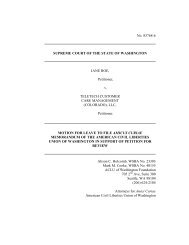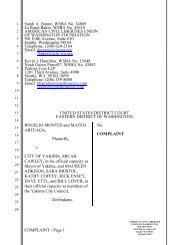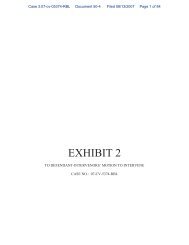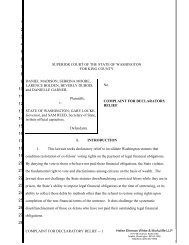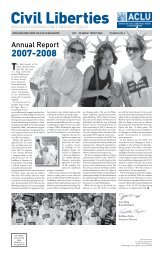BERGER v. CITY OF SEATTLE - ACLU of Washington
BERGER v. CITY OF SEATTLE - ACLU of Washington
BERGER v. CITY OF SEATTLE - ACLU of Washington
You also want an ePaper? Increase the reach of your titles
YUMPU automatically turns print PDFs into web optimized ePapers that Google loves.
<strong>BERGER</strong> v. <strong>CITY</strong> <strong>OF</strong> <strong>SEATTLE</strong><br />
265<br />
Madsen, 512 U.S. at 757-59; Schenck, 519 U.S. at 362-65;<br />
Hill, 530 U.S. at 709-10. Yet, in those cases, where real and<br />
documented threats were present, the restrictions put in place<br />
were still narrower than the flat ban on all “speech activities”<br />
the majority upholds today. See Madsen, 512 U.S. at 760 (ban<br />
on “approaching any person seeking the services <strong>of</strong> the Clinic<br />
unless such person indicates a desire to communicate”)<br />
(emphasis added); Schenck, 519 U.S. at 366 n. 3 (injunction<br />
allowing sidewalk counseling “<strong>of</strong> a non-threatening nature”);<br />
Hill, 530 U.S. at 707 n. 1 (ordinance barring approaching<br />
within eight feet <strong>of</strong> a person entering clinic “unless such other<br />
person consents”). Here, in contrast, the Seattle Center’s<br />
“captive audience” regulation would forbid a political campaign<br />
representative from <strong>of</strong>fering a handbill to a consenting<br />
picnicker in an entirely benign — even silent — manner. Are<br />
we to suppose that such a phantom threat to picnic tranquility<br />
justifies more stringent controls on speech than those gingerly<br />
applied in the Madsen line <strong>of</strong> cases? The majority defends a<br />
draconian solution to an undocumented problem with its<br />
strained reading <strong>of</strong> Dale and Roberts.<br />
Most importantly, perhaps, the majority again forgets in its<br />
invocation <strong>of</strong> Dale and Roberts that it is a public park we are<br />
dealing with: As I have already discussed at length, the tradition<br />
<strong>of</strong> open discourse in such places is central to our constitutional<br />
heritage. There, the balance between the majority’s<br />
purported “right” to picnic in peace and lively, even raucous,<br />
speech has been struck in favor <strong>of</strong> speech since “time out <strong>of</strong><br />
mind.” Hague, 307 U.S. at 515. The speech whose protection<br />
reaches its zenith in public fora extends beyond ideas capable<br />
<strong>of</strong> relatively precise, detached explanation to communication<br />
serving a more emotive function, including efforts to persuade,<br />
entertain, and elucidate through strong language, and<br />
to calls to honor, to disapprove, to shame, and to celebrate.<br />
See, e.g., N.A.A.C.P. v. Claiborne Hardware Corp., 458 U.S.<br />
886, 910-911 (1982) (“Speech does not lose its protected<br />
character, however, simply because it may embarrass others<br />
or coerce them into action.”); Terminiello v. City <strong>of</strong> Chicago,




